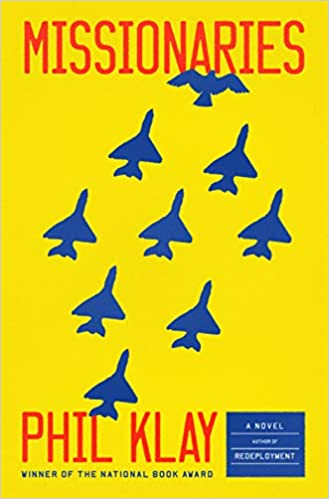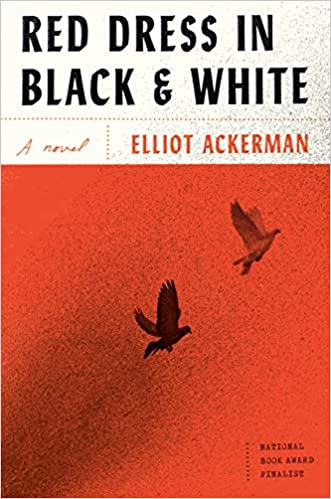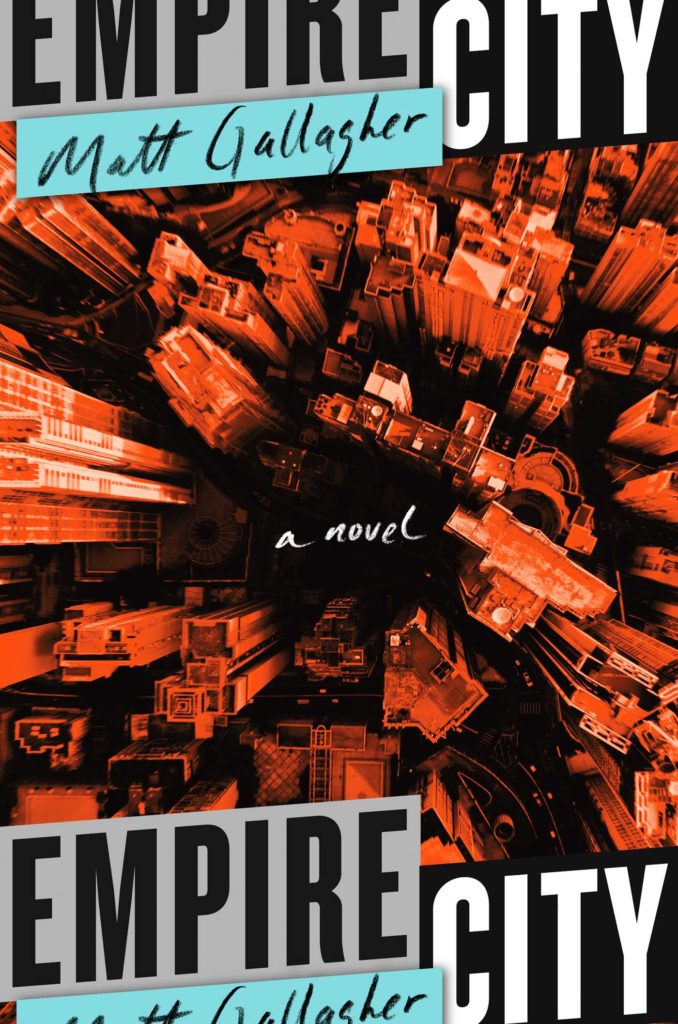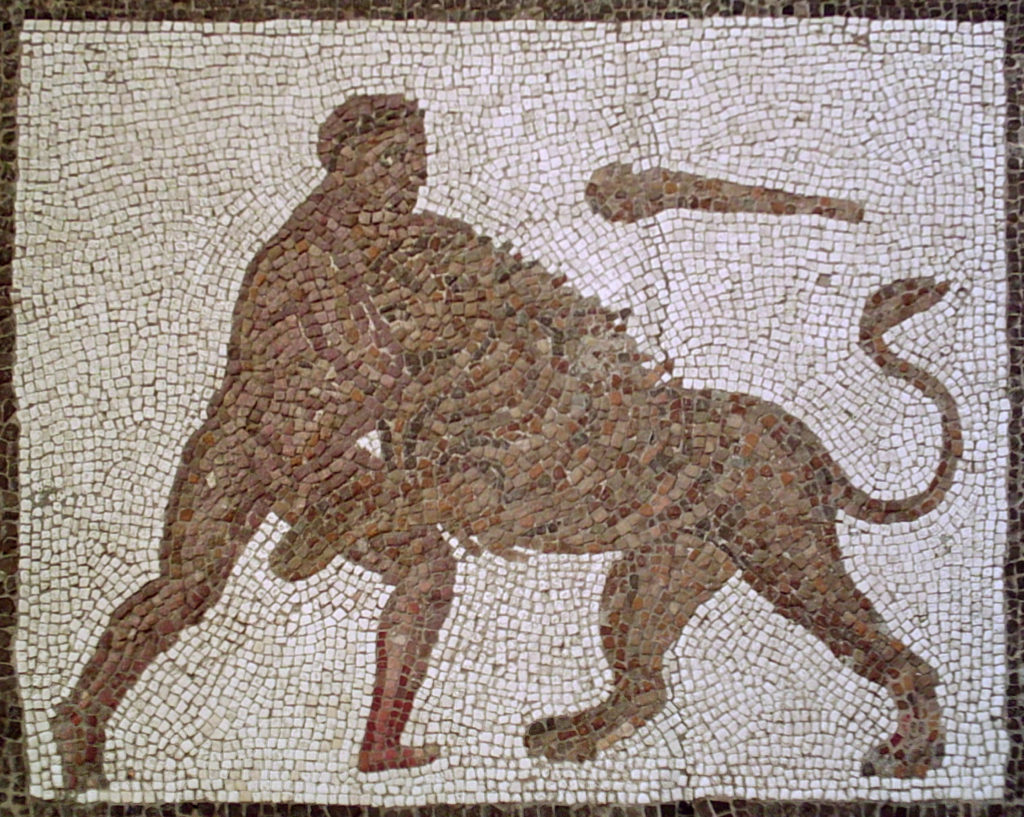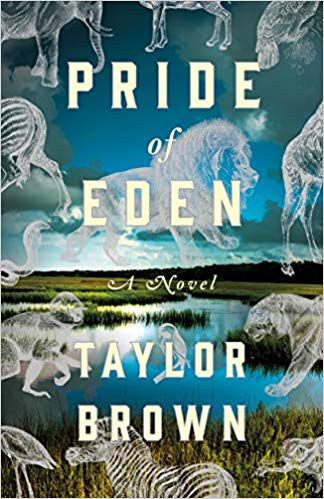Praying at America’s Altar: A Review of Phil Klay’s MISSIONARIES, by Adrian Bonenberger
One of the first books I read was given to me by my father, who got it from his father—a children’s version of the Iliad and the Odyssey. Opening the tome in the garret that was our home, I’d be transported to the vastness of Homer’s Aegean. A giant tome that has fit awkwardly on my bookshelf since, the book’s pages demanded effort and dexterity from my young arms, each revealing some new story or chapter in the war between Greece and Troy, and, later, Odysseus’ long and tortured return to Ithaca.
Beautifully illustrated by Alice and Martin Provensen, the book has a distinctive look that was clearly intended to evoke black-figure and red-figure paintings found on pottery from Greece’s Classical period and earlier. Illustrations often take up more than one page, with action swirling from left to right, and back again, a chorus between the characters, achieving an effect on the viewer not unlike that produced when walking around the urns and amphorae that unfurl stories of Achilles, Hector, and clever Odysseus in museums today.
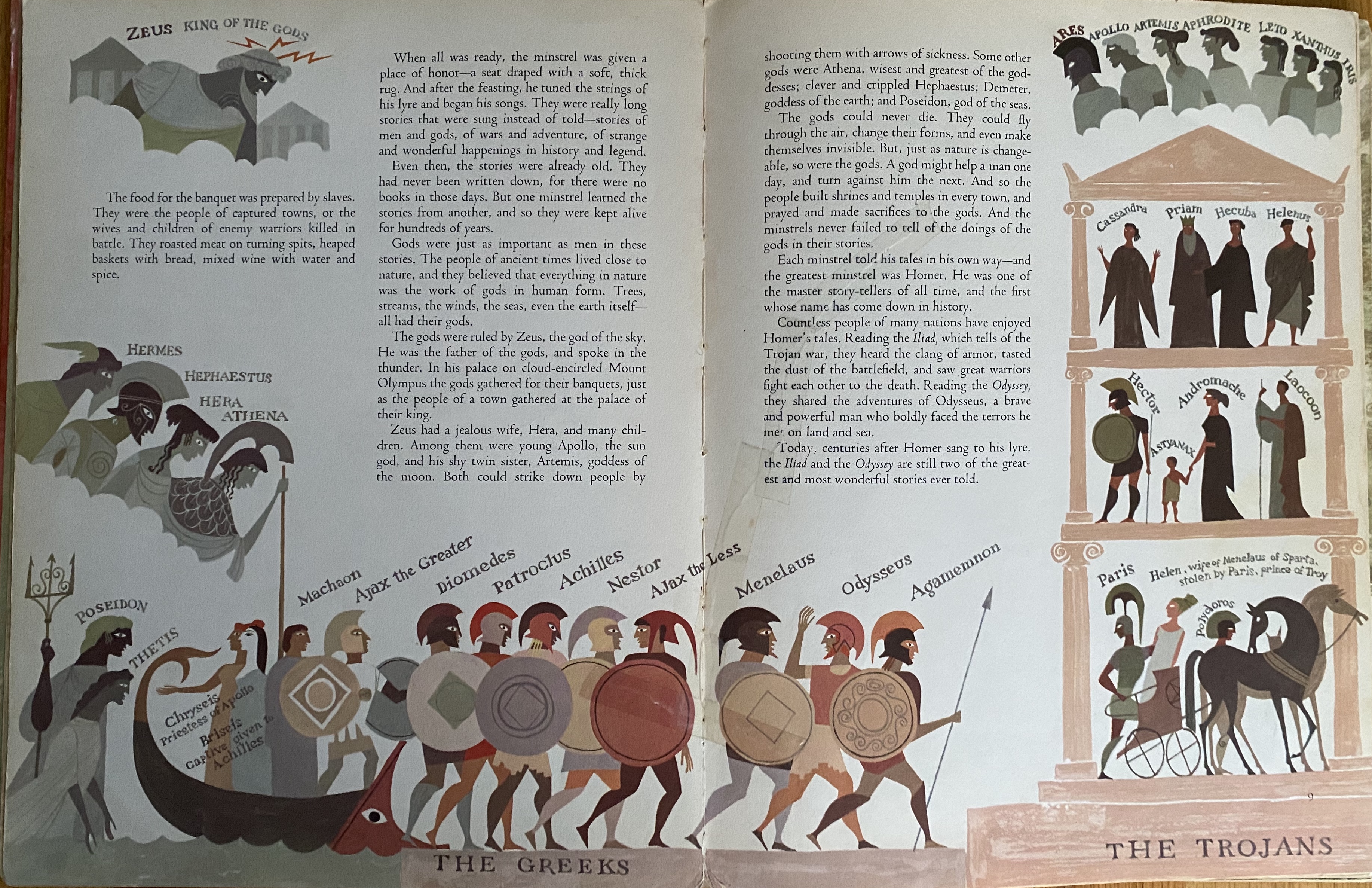
A two-page spread early on in the book introduces the characters together, more or less in context. The pro-Greek gods are arrayed on the left, above the Greek ships, while Greek heroes form a single-file line walking rightward across the page and onto the next, where they encounter the Trojan heroes and other significant Trojan characters in a stylized building. Above that building float the gods who support Troy.
It is a childish device, to introduce all of the characters immediately, and in their context, but this is a children’s book. On those two pages, which almost serve as a glossary, I spent much time—either flipping back to cross-reference my understanding of a particular event, or simply to understand who fit in where with which story. With all of the love and care that went into building this book for children, it is not surprising that a war or wars that occurred nearly three thousand years ago remain entrenched within cultural memory. Indeed, they have come to form a great part of the literary basis of western civilization, and helped shape my own development.
***
Phil Klay’s Missionaries does not introduce its characters all at once, in part because Mr. Klay assumes that his readers are not children who lack object permanence and are capable of holding thoughts in their heads for longer than a minute. Instead, Missionaries offers a sophisticated narrative template, the shape of which organizes further chapters, and accomplishes the goal of stitching disparate storylines and characters together. The point of this device is to bind the journey of its characters together thematically—to create a plot driven by ethical choices rather than linear, temporal accident.
In this sense, Missionaries occupies a place in western literature most sensible to readers 100 years ago. It is a modernist book: things happen for reasons, and rewards are organized around a central ethical framework. It is a moral book: the bad come to bad ends or are thwarted from achieving their plans, and the good are afforded some measure of satisfaction through their choices.
The first character readers meet is a Colombian child growing up in the rural south. He’s devastated by war, a kind of avatar of victimization, losing his parents and home before being rescued from the streets by a Christian missionary. The story moves back and forth between this child’s evolution into a criminal during the 1980s and 1990s and the life of a female conflict journalist covering Afghanistan in 2015.
Klay focuses on these two characters’ arcs in the book’s first section. Later, the story expands to include others—most significantly a special operations soldier who goes into the intelligence sphere, a former U.S. soldier who becomes a mercenary, a paramilitary leader turned drug lord, and a well-bred Colombian officer from a military family and his wife and daughter.
The final section of Missionaries, its denouement, is satisfying in a way that many modernist books are not. Klay avoids the impulse to “get cute” with the story—each of the characters is treated with dignity and respect, even the characters who make bad and selfish choices with their lives, and each one of their endings feels earned. When the journalist is presented with an opportunity to sleep with the mercenary—the two had been in some sort of romantic relationship in the past—what happens between them is both natural and surprising. The Colombian child turned criminal discovers an opportunity to atone for his choices, and how he takes advantage of it is perfectly in keeping with his trajectory.
***
Missionaries carefully avoids endorsing a particular perspective or world-view, which is refreshing given the contemporary moment—characters are rarely driven by politics, nationalism, or philosophy. Perhaps it can be said that Missionaries is not anti-religion. The moments when many characters are at their most empathetic—moments that cannot be discarded later when characters behave selfishly or with cruelty toward others—often involve grace. The hidden hand of God is often seen deflecting or guiding bullets, presenting paths toward redemption, and, ultimately, offering mercy. Not every character takes the redemptive path, not every character accepts the mercy that’s offered. That is part of life, and Klay has represented that sad, tender part of the human experience well. Any adult, looking back over the scope of their lives, will easily find some regretted words or choices, a chance at grace missed. Klay’s characters, too, are beholden to but not quite fully owned by previous choices to a greater or lesser degree that’s magnified as successive generations within a family make choices that accumulate as the years pass.
This is most conspicuously true of the Colombian officer’s family. The officer, an ambitious, cultured lieutenant colonel, has himself been affected by the political and military choices of his father, a disgraced general accused of war crimes carried out by soldiers under his command. This is explained as part of the country’s fight against the FARC, a far-left communist insurgency group aligned with and inspired partly by Che Guevara. The effects of this longtime war are already known to readers, having been described in the book’s first chapter, when the Colombian boy loses his family and village to fighting between the left and right, and the confusing criminal violence that arises in between. By the time the Colombian officer has a daughter of his own, Che has become a popular figure in the capital, a counter-cultural icon, a symbol of South American independence. His daughter has become enamored of a worldview in which the Colombian military is at best a handmaiden of American imperialism, and the FARC a kind of quixotic rebellion against that foreign (to Colombia) influence.
The hard work of the lieutenant colonel’s father to do what seems right at the time—to battle the FARC—has become politically embarrassing, a liability during a time when political leaders are attempting to negotiate peace. The lieutenant colonel’s own work training special operations to American standards in the war on drugs similarly comes to no spiritually uplifting end. But it is impossible to see what either man could have done differently in their lives.
Klay weaves his characters’ arcs together slowly and imperceptibly, or reveals that they have been interwoven all along until all that is left are imperatives to act one way or another, selected out of expediency or faith. Those selected out of the former tend to elevate characters professionally, while further ensnaring them in some greater, obscure plan—one operated or funded by the United States. Those selected out of the latter receive some sort of completion or absolution, and depart from the story.
***
Here is the essence of Klay’s project. Using fiction, he has sketched out an investigative piece no less important than the Pulitzer-Prize winning “Panama Papers.” The contours of the book outline a series of behaviors and practices that, collectively, both define and circumscribe human action—what might, in previous centuries, have been understood as “fate.” The characters inhabit those patterns, unconsciously, living out their lives and loves as best they can. Religion factors into this equation, as does class, ethnicity, sex, nationality, and gender. But the patterns run deeper, and are not accessible to the characters. Envisioned, felt, like some transcendent explanation to which none have access, the truth is exposed only to readers, like a divine boon. The name of that truth is “The United States of America.”
Eventually, everything in Missionaries returns to the U.S. In mysterious ways, everyone gets drawn into America’s orbit of wars and machinations—the War on Drugs, the War on Terror, the various named and unnamed contingency operations sprawling from sea to shining sea. A story that begins in Colombia ends, improbably enough, in an air-conditioned tactical operations center in Yemen. The role of some is to cover the wars, to write about them. Others create the wars, participating in their function as soldiers or officers on one side or another. Others yet fund them, or support them from afar. In this sense every American is a “missionary,” and everyone who ends up taking a side, participating in the great global competition for influence, whether by birth or by choice, is a convert. America is its own God, its own religion, at least when it comes to the everyday, the mundane. America is the context in which violence occurs, America is the bad end of the deal that gets offered to you at gunpoint in some destitute village; America is a romantic liaison in a hotel room with a trusted confidante; America is the family waiting patiently in Pennsylvania or Washington, D.C. America can get you into trouble, but it will get you out of trouble, too, if you suit America’s obscure purposes. America is not grace—America is the novel itself, the entire complicated project. This is not political, it’s not “anti-American” as some might say; it is, as Klay has presented it, a simple and unarguable fact at the center of everything happening in the world today as we know it.
***
My grandfather was a diffident socialist. Largely apolitical, anti-war, having served in WWII, his socialism was the quiet, humanistic sort that started with certain fundamental assumptions and extrapolated from them ways of behaving toward and around others. The only time I recall him being worked up about a particular issue in a political way was to oppose my applying to West Point, threatening to disown me if I attended (who’s to say I would have gotten in? I didn’t apply).
Reading Missionaries, I realized that attending Yale was no different from attending West Point, on a certain level—or Dartmouth, where Klay went, or USC, from which my grandfather graduated thanks to the GI Bill. These places are, essentially, the same, in the way that Iraq, Afghanistan, Colombia, Yemen, Venezuela, China, and America are the same, aspects of a megalithic overarching schema. Socialist, capitalist, communist, religious, atheist, opportunist, everyone inhabits some niche that feeds back into the center. You make choices—attending Yale or West Point or neither—and you live by them. You end up in a war zone, writing about it or fighting in it. Or you pay taxes, run numbers, open a small business, and your tax dollars are spent chasing the traumatized products of war from farmhouse to untenanted farmhouse. Missionaries is about the wars, yes, but because the wars have come to define so much of what is and what we are, whether we like to talk about that or not, Missionaries is us, it’s a 21st century Middlemarch, a 21st century Iliad.
Having spoken with my grandfather at great length while I was in university, and talked with him about his military experiences once I joined the Army, I feel confident that he would have loved this book, and seen in it as much value as the Iliad and Odyssey that he gave to my father. I enthusiastically recommend this to my grandfather, although he passed away thirteen years ago—his aesthetics led him to prefer nonfiction, but he would occasionally make exceptions—and I enthusiastically recommend it to anyone who has seen value in culture and civilization, who wants to better understand the world we live in today, and who values human life regardless of the choices that human makes. For although the structure of our world is not pleasant to many, and most of its poorest inhabitants, if there is any hope, it is that people from different backgrounds and cultural contexts can be kind to one another—that the logic of cynicism is not, after all, the only determinative mode of behavior possible on America’s earth.
Klay, Phil. Missionaries (Penguin, 2020).
